Original | Odaily Planet Daily (@OdailyChina)
Author | Wenser (@wenser2010)

Recently, Huma.Finance, which focuses on the concept of "PayFi network protocol," has attracted significant market attention due to disputes between team members and KOLs, reigniting the heated discussion on "the importance of education in the crypto space." Combined with the launch of the Huma 2.0 system on the Solana network on April 10 and the tariff trade war initiated by the Trump administration, the PayFi sector is gaining momentum again.
In light of this, Odaily Planet Daily will provide a brief introduction to Huma in this article and discuss whether it carries the risk of a blow-up similar to past P2P projects.
Exploring Huma: A New Star in the Solana Ecosystem PayFi
It is worth mentioning that Huma is not a "native project" of the Solana ecosystem but expanded from the Ethereum ecosystem to the Solana network last November source.
In February 2023, Huma completed an $8.3 million financing, led by Race Capital and Distributed Global, with participation from ParaFi, Circle Ventures, Robot Ventures, and others. At that time, the project was positioned as a DeFi lending protocol.
In September 2024, following the completion of a merger with the cross-border payment platform Arf in April, Huma announced the completion of a $38 million financing (including $10 million in equity investment and $28 million in revenue-generating RWA), led by the initial investor Distributed Global, with participation from Hashkey Capital, Folius Ventures, Stellar Development Foundation, and TIBAS Ventures, the venture capital arm of Turkey's largest private bank, İşbank. At that time, the project was positioned as an RWA platform.
It wasn't until the expansion of the ecosystem in November that Huma officially positioned itself as "the first PayFi network."

Huma official website interface
According to official data from the Huma platform, its total trading volume currently exceeds $3.9 billion, total revenue is approximately $3.2 million, and the number of platform points earned (Feather) is around 21.54 million; active liquidity assets are about $74.769 million, PayFi assets are approximately $67.547 million; liquidity assets are around $7.217 million. Additionally, according to Dune data, the average annualized return on the Huma platform is about 14.3%, even higher than the stable return rate of 10.5% provided on the official website; the number of depositors is around 15,000.
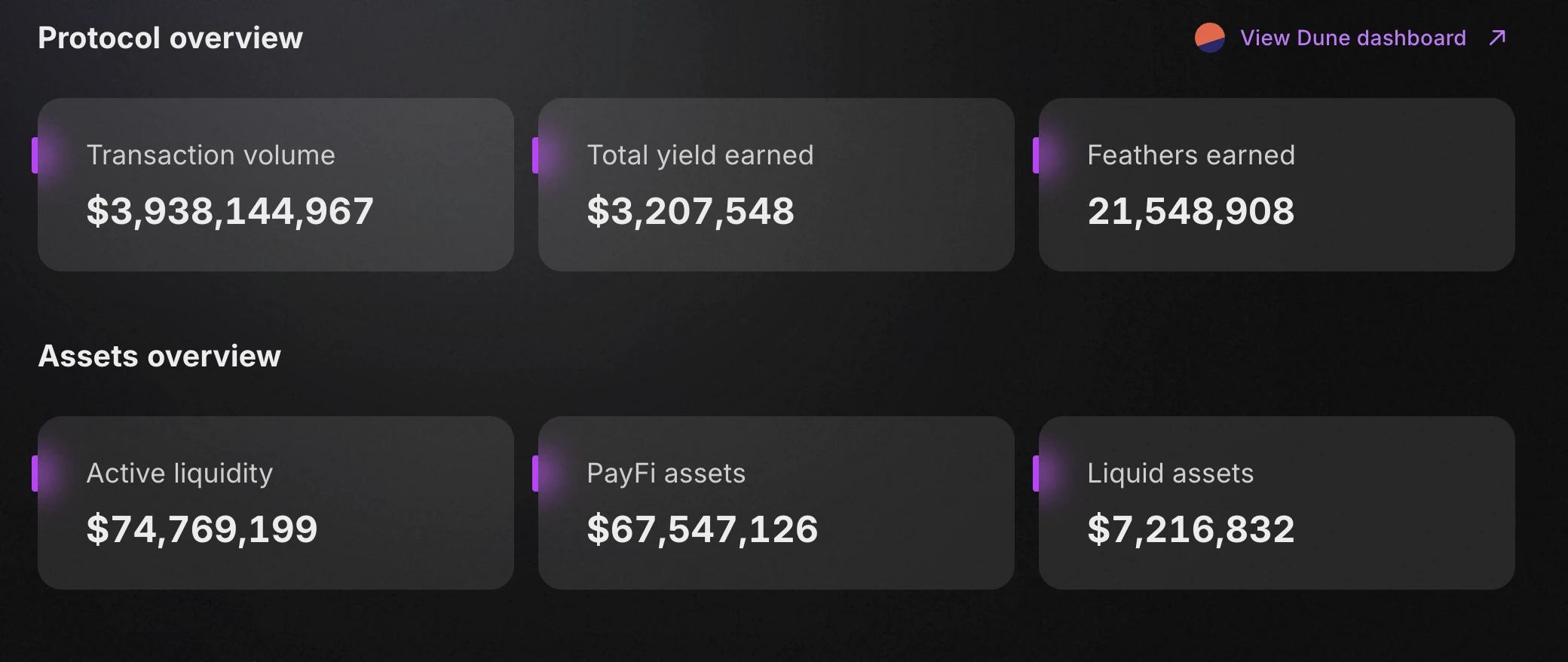
https://app.huma.finance/dataRoom
Moreover, regarding the annual income that users are most concerned about, according to Dune data, Huma's platform annual income has shown a gradual increase since October last year, reaching as high as $8.536 million in March 2025. The total deposit amount of Huma 2.0, which has been online for less than a week, has already exceeded $12.21 million.
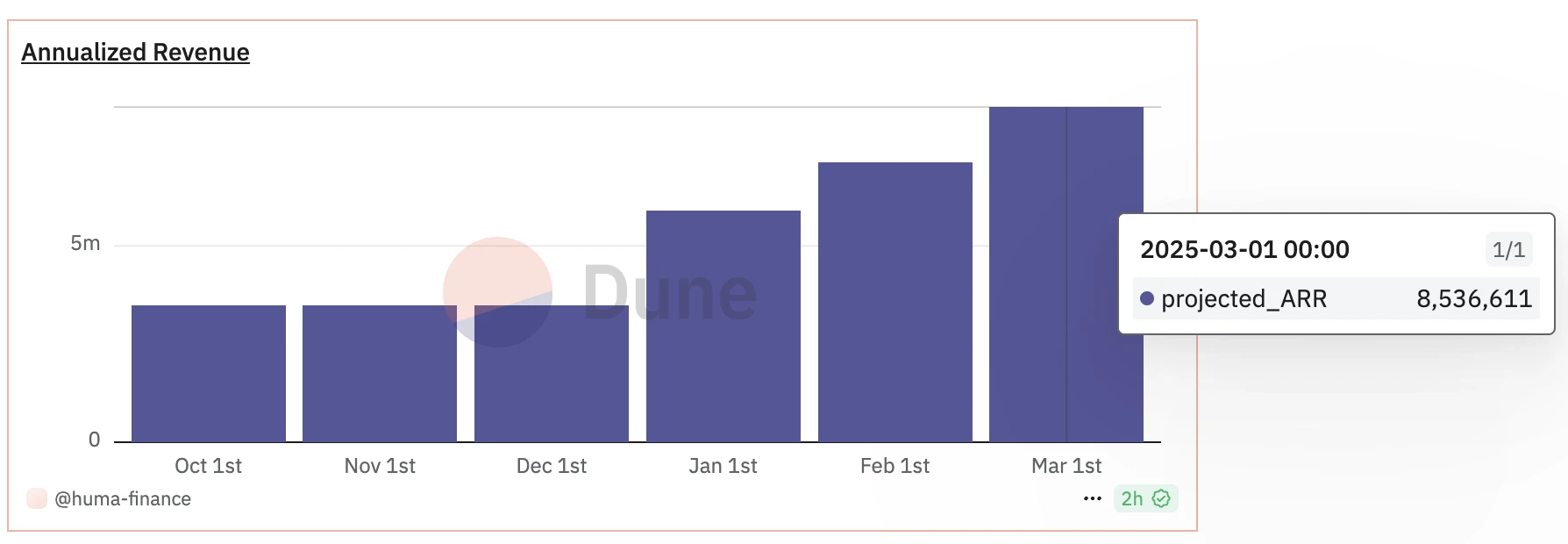
According to previous media information, Huma uses blockchain technology to provide payment financing (or "on-demand liquidity") for use cases such as remittances, credit cards supported by digital assets, trade financing, and global payments T+0 solutions, aiming to address inefficiencies in the traditional financial system. This aspect of the business is mainly conducted through Arf, which, as of April 15, has a cumulative credit limit of $1.992 billion; the total repayment amount is approximately $1.95 billion; and the capital turnover multiple is about 4.31 times.
According to the institutional information provided by the official, Huma currently has three liquidity pools for cross-border payment financing activities, all of which are fully subscribed, with yields exceeding 11.5%.
In terms of DePIN financing, Huma previously launched a router loan purchase plan in collaboration with Roam, where users pay a 30% down payment, and the remaining funds are provided as a loan by Huma. Users will repay the loan through subsequent airdrops and mining rewards, and once the loan is settled, the device's earnings belong to the user.
In January 2025, according to third-party news, Huma will launch the HUMA token on the Jupiter LFG Launchpad, with the expected voting time in May.
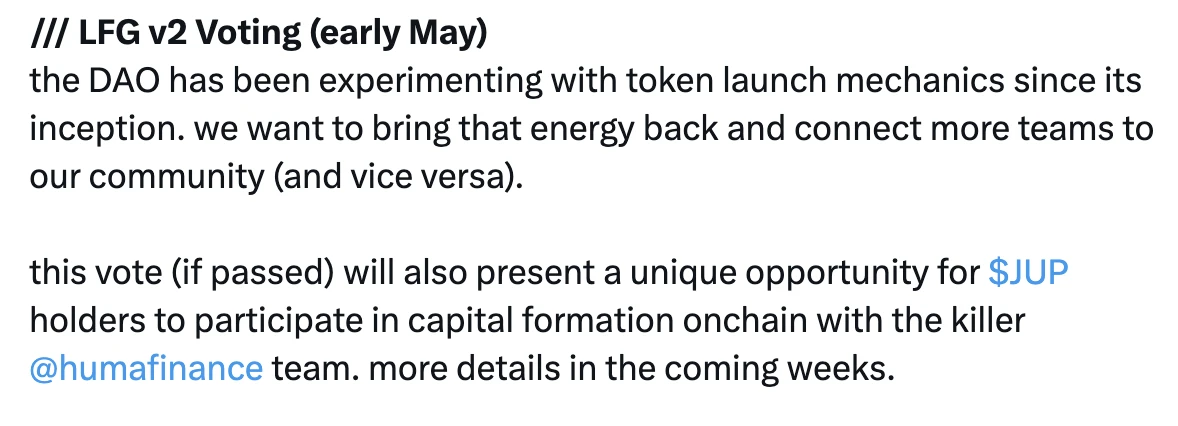
Tentative voting time is in May
After introducing the project, the current participation method for ordinary users mainly involves earning platform yield returns and Feather point rewards through deposits. If one wants to maximize the latter, they can choose the Maxi mode in Huma 2.0; if they want to balance both, they can opt for the Classic mode. The invitation link can be found here.
However, a more pressing question is—does Huma carry the risk of a blow-up similar to traditional internet P2P projects?
Does Huma have the risk of a P2P blow-up? Yes, but not entirely
According to the information provided in Huma's official PayFi strategy memorandum, Huma has proactively disclosed a series of risk factors, including:
Credit and default risk;
PayFi product liquidity risk;
Fraud and misrepresentation risk;
Concentration risk;
Guarantee execution risk;
Pre-financing execution risk;
Regulatory and legal risk;
Macroeconomic and market risk;
And risks related to company operations, technology, and blockchain.
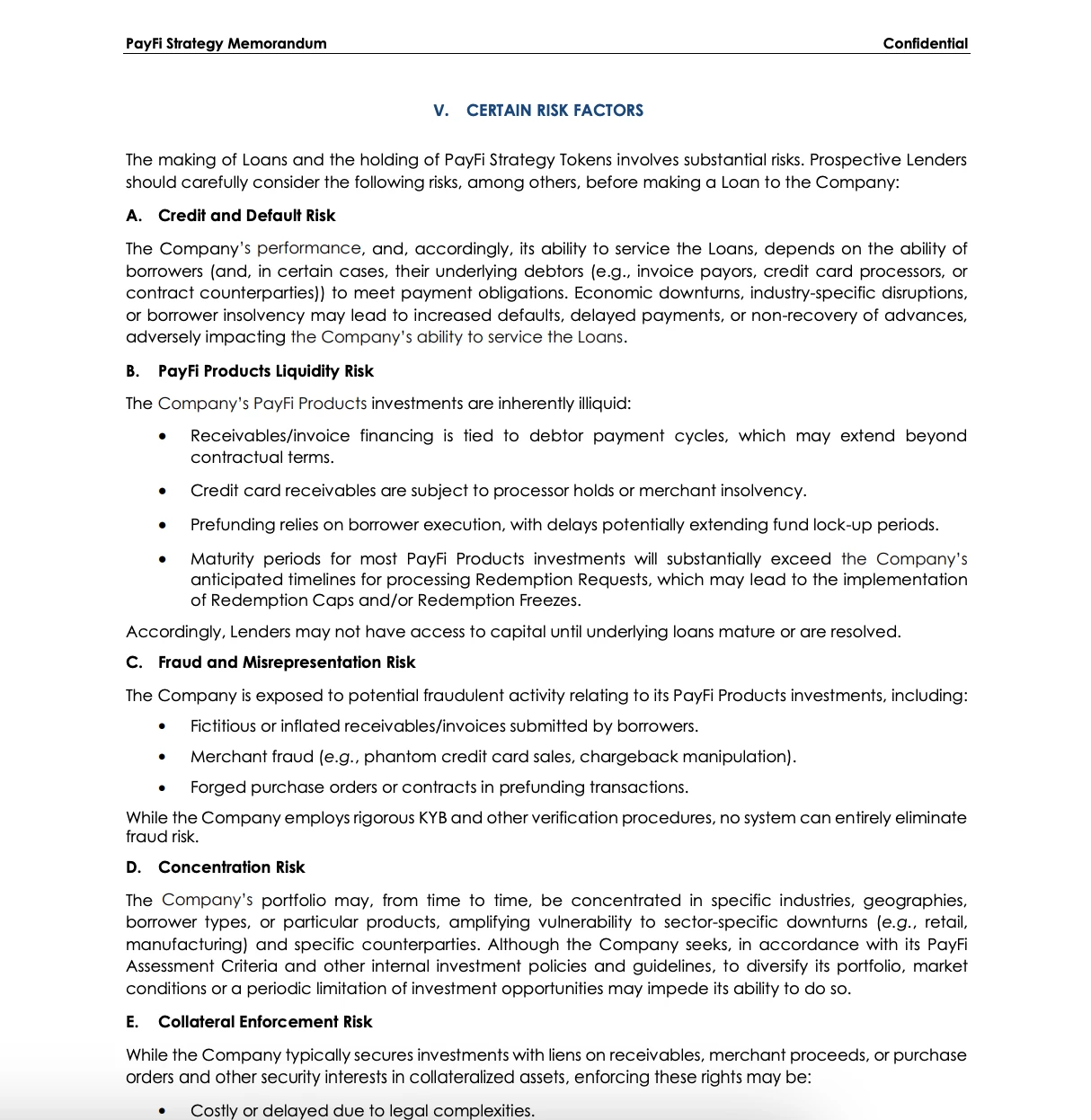
Huma official document information
Additionally, Huma has also provided relevant time and amount restrictions for the user redemption process.

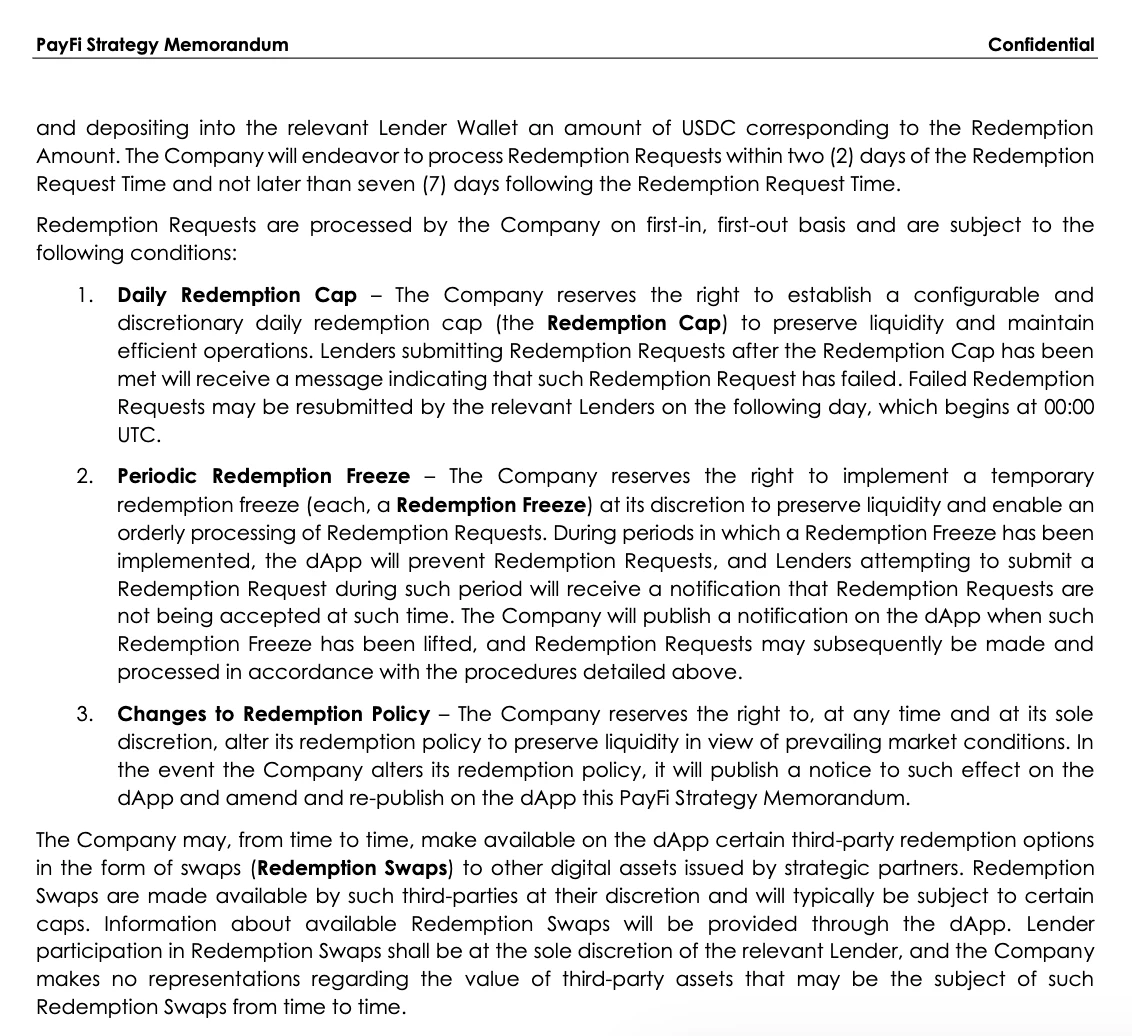
With the official stance on risks being so clear and specific, does Huma really carry the risk of a blow-up? Currently, the likelihood seems low. The main reasons are as follows:
From the existing business model, Huma's commercial model leans more towards connecting enterprises and institutional investors with their liquidity, while offering individuals a token incentive deposit feature that does not require KYC/KYB.
In terms of its underlying assets and risk control mechanisms, Huma uses RWA assets (such as cash-collateralized bonds issued by Arf Capital) for business settlement instead of high-risk P2P unsecured personal loans. The layered structure of Arf's liquidity pool and the platform's coverage of first loss mechanisms also reduce the default risk of lending funds, making liquidity management more flexible (with lock-up periods of demand deposits or 3 months, 6 months).
From the perspective of specific platform functionalities, Huma's PayFi network does have P2P elements, as it primarily connects borrowers and investors through the blockchain network, providing financing based on future income or accounts receivable; however, its focus is on payment financing and RWA tokenization, involving institutional capital and complex financial structures (such as SPV tokenization and structured financing), which differ significantly from the individual-to-individual model in traditional P2P lending.
Regarding credit endorsement and investment institutions, Huma has received support from a series of well-known investment and financial institutions, including Distributed Global and Hashkey, which indirectly reduces the potential for fraud in the project. It is worth mentioning that Huma has not launched platform operations in certain countries and regions (such as the crypto-sensitive areas of China and the U.S.).
Therefore, at this stage, Huma resembles a hybrid business model—it possesses certain P2P business characteristics but primarily relies on providing cross-border payment financing to generate real returns, and on this basis, it expands its PayFi landscape within the Solana ecosystem, introducing partners like Jupiter, Kamino, and RateX (the latter two are currently not open) to explore the potential of the DeFi ecosystem.

Key points for users to focus on moving forward:
Monitor the operational status of the Arf liquidity pool: https://institutional.huma.finance/
Keep an eye on liquidity changes related to the Huma Dune data dashboard: https://dune.com/huma-finance/huma-overview
Pay attention to Huma's official further clarifications on the transparency of revenue sources—Huma co-founder Richard Liu: https://x.com/DrPayFi
In the short term, Huma has achieved a high annualized return and protocol revenue through short turnover cycles and efficient liquidity, and it aims to reach a transaction volume of $10 billion this year with the help of the Arf cross-border payment platform; in the long term, it still depends on Huma's ability to achieve stable returns in stablecoin settlement cards, trade financing, DEPIN project financing, and RWA asset tokenization.
免责声明:本文章仅代表作者个人观点,不代表本平台的立场和观点。本文章仅供信息分享,不构成对任何人的任何投资建议。用户与作者之间的任何争议,与本平台无关。如网页中刊载的文章或图片涉及侵权,请提供相关的权利证明和身份证明发送邮件到support@aicoin.com,本平台相关工作人员将会进行核查。




